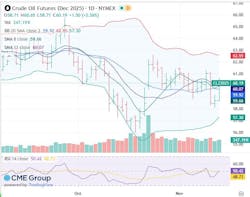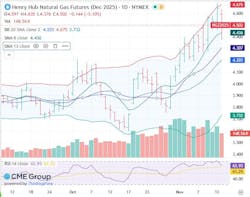Oversupply dominates market sentiment for oil prices
Oil, fundamental analysis
Oil prices moved out of a consolidation period this week both to the upside and downside, resulting in a $3.15/bbl Hi/Lo range for the week. Mixed market signals once again created the pricing volatility as the end of the US government shutdown was a positive development while bearish outlooks and an unexpectedly large inventory gain added pressure to prices. An attack on a key Black Sea port provided a more bullish tone to end the week.
WTI prices reached a weekly high of $61.30/bbl on Tuesday and fell to a low of $58.15 by Thursday but managed to stay above the critical $60.00/bbl mark. Brent followed a similar pattern, hitting its weekly high of $65.30/bbl on Tuesday with its weekly low of $62.35 on Thursday. Both grades settled higher vs. last week while the WTI/Brent spread has widened to ($4.35). Prices are down 15% year-to-date on views of an over-supplied market.
Prices dipped Wednesday as both the International Energy Agency (IEA) and OPEC are now emphasizing a surplus for this year's third and fourth quarters, which will spill into next year. OPEC would later indicate a more balanced position emerging during 2026.
But, by week’s end, prices moved higher as an attack by Ukrainian drones on a major Russian oil export hub impacted both Russian and Kazakhstani exports. Russia’s Lukoil declared a force majeure on shipments from its 75% ownership in the large West Qurna field in Iraq, a sign to some that the US sanctions are having an impact on the company’s international operations.
Industrial growth in China last month slowed to its lowest pace in more than a year. The data, coupled with the filling of its oil reserves throughout the year, is bearish for demand for the world’s No. 1 importer of crude.
The Energy Information Administration’s (EIA) Weekly Petroleum Status Report indicated that commercial crude oil inventories for last week increased while total US oil production hit a new record at 13.9 million bld. vs. 13.4 last year at this time. The US Department of Energy has purchased 900,000 bbl of crude for the Strategic Petroleum Reserve from Trafigura and Energy Transfer at a reported price of $62.00/bbl. The reserve currently stands at 410 million bbl.
Two separate private employment reports indicated significant layoffs last month while Wall Street had its worse day in a month on Thursday as some analysts see an over-investment in AI datacenters as eventually leading to a “bubble” and tech stocks were lower. Despite a rebound Friday, the Dow and S&P indexes were lower week-on-week while the NASDAQ was slightly higher. The USD is lower which is helping to support oil prices.
Oil, technical analysis
December 2025 WTI NYMEX futures are trading around their 8-, 10- and 20-day Moving Averages this week. Volume Friday is around the recent average at 250,000. The Relative Strength Indicator (RSI), a momentum indicator, stayed in neutral territory at 50. Resistance is now pegged at $60.65 (Friday’s High) while near-term critical Support is $60.00.
Looking ahead
An assessment needs to be made of the actual damage to the Black Sea port in terms of the oil shipment interruptions. Oil markets will also be monitoring the impact of the latest round of sanctions on Russian oil which will be in effect in a few days. A successful sale of its foreign assets by Lukoil could blunt some of the effects on oil supply. While near-term forecasts indicated some cold weather-related demand for heating oil, the longer-term outlook is presently bearish. The restart of the US government has helped to fuel a more optimistic view on the economy.
Natural gas, fundamental analysis
December NYMEX natural gas futures continued higher this week again on colder weather and strong LNG exports and despite a storage injection that was higher-than-forecasted.
The week’s High was $4.69/MMbtu on Thursday while the week’s Low was $4.26 on Monday. Supply/demand data was not available this week due to the shutdown. However, LNG export volumes remain at slightly above the 16.0 bcfd level.
In the UK, natural gas prices at the NBP were most recently $10.85/MMbtu while Dutch TTF was $10.65 and Asia’s JKM was quoted at $11.15/MMbtu. The EIA’s Weekly Natural Gas Storage Report indicated an injection of 45 bcf, above the forecasted 34 bcf injection and a 5-year average of +35 bcf.
Total gas in storage is now 3.960 tcf, now 0.2% below last year and 4.5% above the 5-year average. Current levels are similar to last year and represent the highest end-of-season volumes since 2016. If a similar volume is injected this week, we would hit the 4.0 tcf level, matching that of 2016.
Natural gas, technical analysis
December 2025 NYMEX Henry Hub Natural Gas futures stair-stepped higher again this week and continued to move past their 8-, 13- & 20-day Moving Averages. Volume was 155, about near recent averages. The RSI has moved into overbought territory at 63 on this week’s rally. Support is $4.40 (Friday’s Low) with key Resistance at $4.68 (Upper-Bollinger Band).
Looking ahead
Canada is fast-tracking an LNG exportation project backed by Blackstone which is now expected to reach a final investment decision (FID) by next year. Meanwhile, in the US, enough long-term LNG deals have been signed this year that an additional 6 FIDs to be approved. Estimates are for a growth in LNG exports of up to 5.0 bcfd in capacity this year and next. Longer-term temperature outlooks also look bearish for natural gas demand.
About the Author

Tom Seng
Dr. Tom Seng is an Assistant Professor of Professional Practice in Energy at the Ralph Lowe Energy Institute, Neeley School of Business, Texas Christian University, in Fort Worth, Tex.


